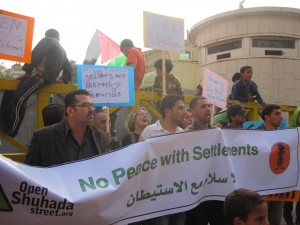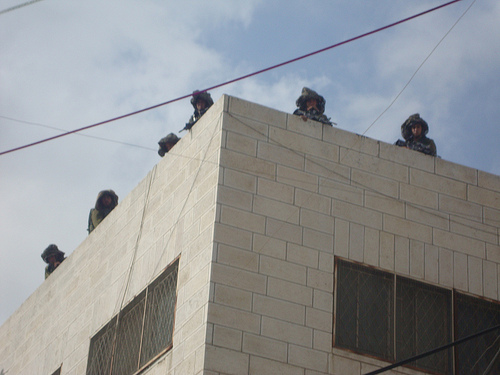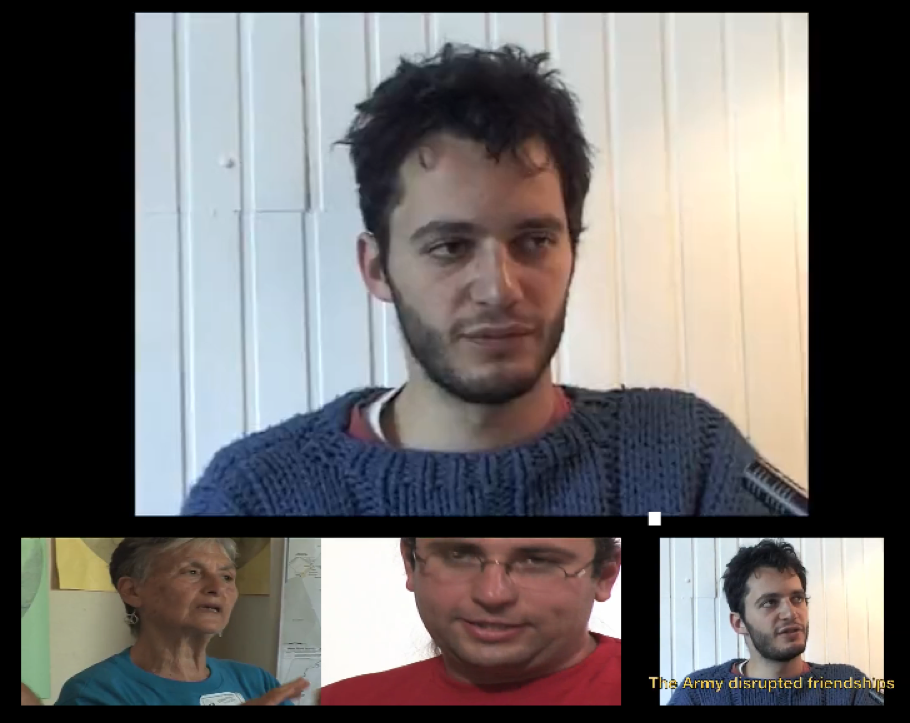The Only Democracy? » On The Ground Reports » Hebron From All Angles
Hebron From All Angles
For the past three Saturdays I have attended the new wave of weekly Hebron protests in the Casbah (Old City). The protests are intended to disrupt army-accompanied settler tours that pass through the Casbah each week, and demand the re-opening of Shuhada Street and an end to the occupation of the city. Although for the past two weeks the settlers have changed the time of their tour to avoid encountering our protest, we decided to continue with the protests as planned to assert the Palestinians’ right to move freely within their city. So, each week a group of between 50-70 Palestinians, Israelis, and Internationals gather in front of the gate which blocks entrance to Shuhada Street.
We stand with signs in Arabic, Hebrew, and English and pass the megaphone around as different people lead the protesters in a series of call and response chants in all three languages. Some activists take the opportunity to give short impassioned speeches, sometimes by Israelis who speak directly to the soldiers and settlers peering down on us from the Beit Romano Yeshiva rooftop, saying that these unjust policies will not be carried out in our name. In contrast to the first week when the protest ended in a series of unwarranted arrests, the protests now conclude now with a march through the Casbah which is met by an onslaught of dirty water thrown down on us from the settlers’ homes situated above the Palestinian shops. For the past two weeks there has been no direct confrontation with soldiers or settlers, but we always close with a promise that we will continue to protest every week until racism and separation are abolished in Hebron and all of Palestine.
This past week, just a few days after standing in solidarity with the Palestinians of Hebron, I decided to take a step that I believe very few political activists ever take. I put on a long skirt, tucked my dreadlocks away, and joined the settlers on their tour of the Jewish Community of Hebron. After having been to Hebron many times and heard the story of the Palestinians and the ex-soldiers of “Breaking the Silence” I figured it was time to come face to face with the settlers themselves and hear how they justify their presence in Hebron to the many thousands of Jews that they’ve taken on tours there. I came with the intention to listen, to observe, and to maybe understand their conviction.
So on Wednesday morning I found myself sitting on a bullet proof bus with a group of 40 other American Jews about take a day-trip to Hebron, a city that I was assured by the tour guide is just like any other old city in Israel. Even before the tour had officially started, I already began to feel uncomfortable and almost teary eyed due to the realization that all the other tour participants really had no idea (and really didn’t care that they didn’t) about the world beyond this Jewish exclusivity. Little did I know that that this initial reaction of discomfort and sadness was to remain with me and only intensify throughout the course of the day.
Our first stop was the Matriarch Rachel’s Tomb which is just outside, (technically inside) Bethlehem. To reach the tomb we drove through an unbelievably surreal corridor in the concrete wall that circumvents Bethlehem. Since Israelis are not allowed to enter Bethlehem, this access road, entirely surrounded by the wall, has been created for Jews to visit and pray at the tomb. As the tour guide told the story about a time when the grave was closed to Jewish access and how women from Hebron set a precedent by coming anyways and demanding to be let in until the government agreed to re-open the site to Jewish visitors, I realized that all this effort to keep people separate and relegated to only certain areas is futile because people will continue to find ways to be where they believe they ought to be, or at least struggle for that right with all of their being as I’ve seen with the Palestinians in Hebron.
For some reason, being there only made me think more and more about how this land cannot be divided. Of course I don’t mean undivided in the way that the settlers refer to Greater Israel, but rather that in that moment it just seemed so apparent to me that drawing up borders and erecting walls cannot actually lead to real justice or peace; they merely restrict essentials freedoms such as access and movement, and furthermore will never suppress the people’s desire to return to areas that they have been barred from. Religious Jews will never give up their ancestral connection to and right to access these holy sites, and I don’t believe that they should have to, but this privilege must come with the equal recognition of the Palestinian claims to this land and their legitimate right to live here and move about freely.
Loaded with these thoughts I got back on the bus headed to Hebron. I listened as the guide told the familiar story of Hebron that began 3700 years ago when Abraham laid down roots in the city and purchased the Cave of the Patriarchs as a burial site for his wife Sarah, and the forefathers and mothers that followed. Later, King David made Hebron the capital of his kingdom for 7 years before moving it to Jerusalem. The phrase that repeated itself throughout the tour was “this is where it all began”, which later fused into the story of Jewish contiguity in Hebron, and finally the conclusion that the Jewish presence in Hebron will be eternal.
When we arrived in Hebron we were greeted by our tour guide for the next leg of the journey, Rabbi Simcha Hochbaum, originally from New York but for the past 14 years he has made his home in the Hebron Jewish community. The tour started in Tel Rumeida, a hilltop overlooking the heart of the city of Hebron where a few of my Palestinian friends/colleagues live. The guide explained the way the city had been divided in the “Y Accords” which created H1 (80% of the city under Palestinian Authority control) and H2 (20% of the city under Israeli military control and Palestinian municipal control). He continually referred back to the 80/20 split to emphasize what he believed to be inequality and discrimination against the Jews who are not allowed to walk or drive in the majority of the city. In fact, after reading a pamphlet I picked up later in the tour which purports to give the “real facts…in contrast to the false anti-Jewish and anti-Israel propaganda,” I was expected to understand that Jews are only allowed to enter 3% of the municipal area; never mind that that 3% area was once the center of Palestinian social and economic life and the gateway to the rest of the city, and never mind that that statement is actually inaccurate because it is not Jews but Israelis that are prevented from entering H1 (according to the Oslo Agreement) and Israelis are in fact allowed to be anywhere in H2 (the 20% mentioned above). This important distinction between Jews and Israelis was intentionally blurred by the tour guide in order to stress his point that anti-Semitism is what lies at the root of all criticism towards the Hebron Jewish community. In reality, the disputes in Hebron are entirely political and not based on religious identity.
Israeli soldiers patrol H2 constantly, practicing the official policy of “making their presence felt,” and it is certainly felt as they are seen constantly peering down, guns at bay, into Palestinian neighborhoods from rooftops (sometimes Palestinian homes that have been taken over and converted into army posts) and pillboxes throughout the city. Of course, this is all information that I learned on the “Breaking the Silence” tour and was not dealt with in any capacity on the settler tour. The tour guide praised the soldiers for their incredible self-sacrifice, but the impression of the soldiers that I get, from starting directly into their eyes as they push my friends and I during protests and from the many testimonies that I’ve heard from members of “Breaking the Silence”, is one of a group of painfully confused and uncomfortable 18-21 year olds who are stuck in positions of power and aggressiveness that throw their concept of right and wrong into a blender, leaving them hardened and numb.
Back on the tour, I was told that I would experience holy people in Hebron. The 1000 Jews that live there believe themselves to be the ones who have taken on the essential responsibility of carrying the eternal Jewish flame in Hebron in the name of our ancient historical connection to the city. Of course learning about and appreciating this history is important, but Hebron especially is a place that cannot be understood separately from its current political context. Referring to the 80% of Hebron that is under PA control as land that was “given away” and the remaining 20% as land that “unfortunately is shared with 15,000 Palestinians” is simply a tactic to confuse the tour participants and make them forget that Hebron is (and has been) a city of several thousand Palestinians living under military occupation. Throughout the tour, the only time Palestinians are mentioned or even acknowledged as part of the story is when they are referenced as “unfriendly neighbors”, murderers/terrorists, or hookah-smoking couch potatoes. Furthermore, talking about the restrictions on further building and expansion in the settlement cannot simply be received as a baseless effort to discriminate against Jews, but rather must be situated in the context of the larger West Bank settlement issue, namely that the settlements are illegal under international law, some (especially Hebron) are notorious for violence and extremism, and they are a growing thorn in any attempt towards a peace agreement.
Perhaps the most interesting and telling part of the tour for me was when we went into the settlements themselves, which basically consist of just a few blocks of buildings that families have made into living spaces, synagogues, and a museum documenting the presence of the Jews in Hebron. In all my previous tours in Hebron I had never had the opportunity to actually go into their community so I was quite excited to step just a few more meters from where I had always stood, on the Shuhada “ghost street” and see how Hebron looks from this vantage point. On my other visits I was not allowed into the settlements because the large police escort that is mandated to accompany Breaking the Silence tours (supposedly to protect us from settler harassment and prevent friction) had placed strict restrictions on where we can go and when. But this time, with not a single police officer in sight, I found myself on the other side of barriers that I previously had only peeked into through cracks in walls and metal gates.
The museum, located on the ground floor of the former Beit Hadassah hospital, was quite impressive and most importantly, effective in conveying the message that Jewish groups respond to best: the message of ultimate victimhood. As I looked at the pictures on the wall depicting the infamous massacre of Jews in Hebron in 1929, I felt a sort of déjà vu sensation and realized that the story being told was the nearly the same story that I had heard countless times growing up and visiting holocaust museums. It was the fear-mongering story of anti-Semitism, complete with the moral imperative “never again.” And in that moment, instead of being able to let myself grieve for all the bloodshed in Hebron, I found myself shaken by the realization that this story is entirely believable for a Jewish American audience and, had I not been exposed to other credible accounts of Hebron, I too could come away from this tour thinking that the settlers really are the ones in need of my sympathy.
But then I remember the accounts of settler abuse and complete disrespect for Palestinian human and civil rights and I start to feel ill. I understand that this mentality does not exist in a vacuum, but rather is steeped in real and troubling consequences that play out on the ground, such as the closure of roads and shops, the disproportionate army presence, the lawlessness of the settlers, and the will of the Israeli government to continue supporting the settlers perhaps for fear of being perceived as part of the cycle of Jewish persecution. I think about the Jewish residents of Hebron pre-1929 who once lived relatively peacefully alongside their Palestinian neighbors, unlike the settlers of today who make every effort to create a situation in which Palestinians essentially cease to exist. I happen to know that some of the survivors of the 1929 massacre or descendents of the former Hebron Jewish community have actually disassociated themselves with the Hebron settlers and do not support their efforts to reclaim the city on their behalf. Yet this Jewish lineage continues to justify the settlers’ presence and forceful methods of establishing themselves in the city.
The tour continued with a visit to the guide’s home, the old Sephardic temple, and a final stop at the Tomb of the Patriarchs where we were given time for prayer. After spending the day in what often felt like an alternate universe I didn’t feel quite able to ascribe the proper holiness to the site and submit myself to any prayers aside from my deep yearning for universal empathy and for at least some of their tour participants to feel confused enough to then seek more information, step outside of their frame of reference, and think beyond the simplistic rhetoric of pamphlets espousing hatred and resentment. I went on this tour out of genuine curiosity and a desire to understand a people that are often (in my circles) written off as crazy and irrational. But after participating on the tour, it wasn’t so much what they said that troubled me, but rather they way that the story fits into a worldview based in fear that is held by so many Jews and that has only resulted in generations of bitterness and divisiveness. I want to believe that Hebron can again live up to its name (which means “friendship”), but this tour gave me no such illusion.
Filed under: On The Ground Reports · Tags: Hebron, Open Shuhada Street, Settlers, Tours










 “You have a choice! Israeli Anti-Militarists Speak”
“You have a choice! Israeli Anti-Militarists Speak”